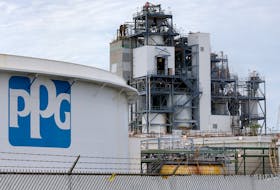Not everyone in the sector has accepted the clear science, but experience is forcing the industry as a whole to the table regardless, particularly for farms with succession plans.
Climate change forecasts would seem to suggest good news for agriculture here in the coming decades, with an extended growing period and fewer frost days — but there is a caveat, as ongoing changes also provide conditions ripe for shifts in disease, expanded range of some pests, heavy storm rains and soil erosion.
RELATED STORY
N.L. agriculture will meet its goals: federal minister
RELATED LINKS
Agriculture and Agri-Foods Canada — Greenhouse Gases
Environment and Climate Change Canada — Emissions by sector
On the cranberry farm
Sean Dyke is a cranberry farmer, operating the Peters River Cranberry Farm in Wooddale South. He said he’s concerned with the idea of more sudden, heavy rainfalls.
“Though I’ve only been in operation for seven years, I have experienced on two occasions floods from rain storms which I have wondered if they are a normal occurrence or as a result of climate change,” Dyke stated in an emailed response to questions this week. “The first was hurricane Igor, which inundated our cranberry fields (which were under construction) with about a foot of water, and the second was last fall’s Thanksgiving Day storm which washed away two of my newly constructed berms and filled parts of my fields with debris.”
Both events were beyond average storms and, in the latter case, he said, an access road was washed out and remained impassable for a couple of days.
Dyke sees himself having to install even more, higher berms in preparation for future storm events.
In the greenhouse
Kim Thistle co-owns and operates The Greenhouse and Garden Store in Little Rapids and said climate change is an everyday topic at her home and business. She grows plants for flowerbeds and landscaping, but also grows vegetables.
“We have already had to change the way we do things where irrigation, length of season and crops planted are concerned,” she stated.
She has been exploring the possibilities in an extended growing season — experimenting with new plants and crops that would not have been considered 10 years ago, like sweet potato and ginger.
The flower business has changed also, she suggested, given some consumers are keeping outdoor plants, including baskets, longer into the fall.
Coming around to spring, she said she used to expect any late frost in mid-June, but the landmark in her area is shifting earlier and earlier.
At the U-pick
At the Campbellton Berry Farm in Campbellton, Philip Thornley said for success in a given year he’s looking at temperature, rainfall, fertility and any one-off events like frost. If any one is not right, it can cut into the yield.
Generally, conditions have been changing, Thornley said in an interview the week, but the main thing he’s found is less predictability than in past years.
“What I can say is it’s certainly more variable and that variability has a huge impact on farming. I don’t know if the general public realizes just how much,” he said.
Being prepared for the variability requires more on the part of farmers — diversifying products, adding to water-handling systems (for example, irrigation and water retention ponds) and other measures. It will all come at a cost, on top of the reality of higher risk of overwhelming and damaging weather events.
“What it means is food is going to get more expensive, because if we’re to cover and mitigate for those disasters, we as farmers must put more in,” Thornley said.
“Society has undervalued farming for way too long and is going to have to put the resources in, if they want food consistently.”
On emissions and evaluating risks
Merv Wiseman, president of the Newfoundland and Labrador Federation of Agriculture, was in St. John’s on July 18 with then-provincial Land Resources minister Steve Crocker and federal Agriculture Minister Lawrence MacAulay to announce a new risk-assessment project for this province’s farmers.
Wiseman was asked by The Telegram if the evaluation would encompass risks extending from climate change.
“It’s a big one,” he said, explaining it is part of the ongoing project.
He said the politics of climate change and its many related topics also formed part of the discussions at the meeting of the Canadian Federation of Agriculture, coinciding with the agricultural ministers’ roundtable the federal and provincial ministers co-hosted at the time.
“Front and centre on our agenda is how do we deal with climate change issues?” Wiseman said. “How do we, as farmers, work against the backdrop of climate change and the expectation that we reduce greenhouse gas?”
In terms of contributions to greenhouse gas emissions, carbon dioxide is released from cultivation of the soil, methane comes from cattle and livestock manure, and nitrous oxide comes from use of fertilizers. But nationally and provincially, emissions from the oil sector and transportation sector are greater then emissions from agriculture.
In some provinces, agriculture’s share of total greenhouse gas emissions runs higher. Manitoba, for example, attributes nearly 30 per cent of total emissions to agriculture. In Newfoundland and Labrador, emissions from agriculture are actually outstripped by emissions from solid waste disposal (think gases escaping as garbage decomposes at landfill sites). In 2015, Newfoundland emitted 91 kilotons of carbon dioxide equivalent from agriculture, compared with 776 kilotons from waste.
But Wiseman said the federation locally is keeping watch for any blanket policy.
Farmers in this province have already shown a willingness to help reduce emissions, he said, and the official position is any legislated requirements introduced (as a hypothetical) be cost neutral, given the financial pressures farmers already face.
He said information gathered through the ongoing risk assessment project will be used in developing future programs to support a more resilient agriculture industry, including consideration of climate change.
A consultation session for the risk project is scheduled in St. John’s on Monday, Aug. 14 at the Ramada Inn. Registration is required. A full schedule and additional details are available online.
GHG emissions:
Enteric fermentation (gas direct from cattle, sheep, goats) — 36
Manure management — 22
Agriculture soils (decomposition and tilling) — 12
Field burning of agriculture residues — 0
Liming, urea application and other carbon-containing fertilizers — 21
Total: 91
(All values = kilotons of carbon dioxide equivalent, 2015)
Source: Government of Newfoundland and Labrador, Office of Climate Change; N.L. Agriculture









